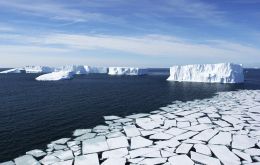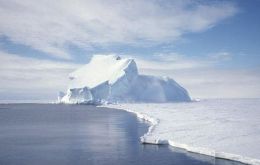MercoPress. South Atlantic News Agency
Tag: Antarctic Ice Sheet
-
Thursday, February 24th 2022 - 07:47 UTC
Antarctic sea ice set of a new record low minimum, Greenpeace

Greenpeace reports that data from the National Sea Ice Data Center shows that this year Antarctic sea ice will reach the lowest extent on satellite record. Preliminary measurements show the sea ice around the continent has surpassed the previous record minimum set, in March 2017, of 2.1 million square kilometers, dropping to 1.98 million square kilometers on Sunday 20 February.
-
Thursday, June 14th 2018 - 07:24 UTC
Antarctica ice sheet melting faster than expected, adding 0.6mm to sea level every year

The Antarctic ice sheet has lost more than 2,500 billion tons of ice in the past 25 years and nearly half of that has happened since 2012. An international team of polar scientists found that melting in Antarctica has jumped sharply from an average of 76 billion tons per year prior to 2012, to around 219 billion tones each year between 2012 and 2017.
-
Friday, January 15th 2016 - 08:06 UTC
Strong hints of a vast canyon system hidden under the Antarctic ice sheet

A vast, previously unrecognized canyon system could be hidden under the Antarctic ice sheet. Hints of its presence are seen in the shape of the white continent's surface, in a largely unexplored region called Princess Elizabeth Land. If confirmed by a proper geophysical survey - now under way - the winding canyon network would be over 1,000km long and in places as much as 1km deep.
-
Wednesday, May 28th 2014 - 22:04 UTC
Antarctica ice sheet melting episodes have occurred over the last 14.000 years, say scientists

A new study has found that the Antarctic Ice Sheet began melting about 5,000 years earlier than previously thought coming out of the last ice age, and that shrinkage of the vast ice sheet accelerated during eight distinct episodes, causing rapid sea level rise.
-
Wednesday, September 5th 2012 - 00:44 UTC
Antarctica could hold large volumes of methane, warn British scientists

Large volumes of methane - a potent greenhouse gas - could be locked beneath the ice-covered regions of Antarctica, according to a new study. Methane could be released into the atmosphere as ice retreats, contributing to climate warming.
